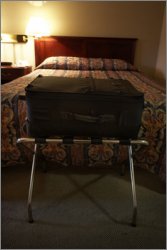Eight Steps to Take if You Ever Experience the
Frustration of Lost Luggage
by www.SixWise.com
You watch the baggage carousel wind around for what seems
like the millionth time, start to see the same five bags circling
over and over, and then the carousel winds to a slow, but
very final, stop.
|

Your first step when your luggage is missing? Report
it to the airline before you leave the airport.
|
Only then, with a sinking feeling in your gut, do you admit
to yourself that your suitcase is not there.
Now what?
First realize that you are not alone. There were eight reports
of mishandled luggage (lost, damaged, delayed or pilfered)
for every 1,000 passengers in August 2007, according to this
month's Air Travel Consumer Report (a monthly product of the
Department of Transportation's Office of Aviation Enforcement
and Proceedings (OAEP)).
Often, your bag may not actually be lost; it may simply be
delayed. According to the U.S. Department of Transportation
(DOT), about 98 percent of delayed bags are returned to their
owners within a few hours. However, there are all-too-many
horror stories of the other 2 percent of bags. The ones that
don't show up for days or weeks, perhaps not even until after
you've returned home.
Now, regressing back to the baggage carousel. You realize
that your bag is not there. What should you do? Here are the
immediate steps you should take:
-
Report it to the airline BEFORE you leave the airport.
-
Insist that the proper form is filled out regarding
your claim, and be sure to receive a copy of it. Have
a form filled out even if the airline assures you your
bag is on the next flight.
-
Make sure you write down the name of the airline representative
you're dealing with and a follow-up number (this should
NOT be the same number as the reservation desk).
-
Find out how your bag will be delivered to you if it
is found. Note that some airlines will charge you to deliver
it, or may not offer an option of delivery at all.
-
Ask whether you can get a cash advance for emergency
purchases. Most airlines do have discretionary money for
this purpose, but the guidelines for who receives it depend
on whether you're away from home and how long it takes
for your bags to be returned.
-
If you don't get a cash advance (or don't opt to) ask
the representative what purchases are reimbursable. Keep
all of your receipts for items purchased, and note that
the airline may only reimburse you for a portion of the
cost, because you will be able to use the new items in
the future.
-
If the matter is not fully resolved by the time you
leave the airport, keep a record of every airline representative
you dealt with and keep all of your receipts and travel
documents (it IS OK to give the airline your baggage claim
tags, according to the DOT, as long as it is written on
your form (and theirs) that you have returned them). Then,
call the airline's consumer office when you get home.
-
In the event that your luggage is, indeed, lost (not
just delayed), you will have to file a claim with the
airline. This usually involves filling out a second, more
detailed form. Here's what you need to know to file a
claim for lost luggage:
|

One way to make sure your bag gets to the same location
as you? Check the three-letter code on your luggage
tags when you check-in with your airline. They should
correspond with your final destination.
|
-
There are deadlines involved. Find out what they are
or your entire claim could become invalid.
-
Inquire about all the necessary paperwork you need to
fill out, and be sure to fill out said paperwork in full.
-
If your flight involved two airlines, the final airline
is usually the one who processes the claim (even if the
first airline lost the bag).
-
Be prepared for negotiations. Depending on the amount
of your claim, the airline may ask you for sales receipts
and other documentation. If you don't have them, you can
expect to go back and forth about what's a fair price
for your goods.
-
Airlines may have liability limits of $3,000 per passenger
on domestic flights (limits on international flights vary).
If your baggage is worth more than this, purchasing "excess
valuation" when you check in will increase the airline's
potential liability (though it will not guarantee you
receive the full amount).
-
It can take anywhere from six weeks to three months to
receive payment for lost luggage.
-
If you decide to take an offer for free airline tickets
that are valued at more than your settlement in lieu of
cash (a deal that airlines sometimes offer), make sure
you find out about blackout dates and other travel restrictions
before you commit.
-
If you aren't happy with your settlement, you may have
other options. Homeowner's or renter's insurance sometimes
covers lost baggage, as do some credit card companies
and travel agencies.
How to Increase the Chance That Your Bags Will Arrive
When You Do
Sometimes, a lost bag is purely due to chance -- your bag
tag gets ripped off by a conveyer belt, your suitcase gets
mysteriously rerouted and misses your plane, a baggage handler
mistakenly loads it onto the wrong cart, etc.
There are ways, however, to give your luggage the best chances
of reaching your destination alongside you. The following
tips take hardly any extra time, and could save you the headache
of having none of your possessions on your next trip.
-
Label your luggage with your name and phone number (minimum),
and also your address, both INSIDE your suitcase and out.
-
Make sure your bag is securely closed and can't pop open
easily.
-
When you check in, make sure the agent puts a tag on
all of your bags.
-
Also check the three-letter airline code on each tag.
It should match up with the airport of your FINAL destination.
-
If possible, hang around until you physically see your
bags being loaded, tags intact, onto the conveyer belt.
If you want to go above and beyond, and really protect yourself
(or if you've lost a suitcase in the past and aren't taking
anymore chances), you can also:
-
Make a list of what's included in each of your bags,
including the estimated values
-
Take a picture of the contents of your bag
-
Consider buying excess valuation if you know your luggage
is worth a lot
-
Not check any bags ... and stick to carry-on luggage
instead!
Recommended Reading
How
to Travel Abroad Safely: Six Important Tips You Need to Know
in an Emergency
The
Risk of Flying in Small Airplanes vs. Large Airplanes
Sources
U.S.
Department of Transportation